New publications
Plants
Juncus
Last reviewed: 29.06.2025
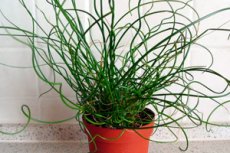
Juncus is a genus of perennial herbaceous plants from the Juncaceae family. These plants are often called rushes due to the characteristic structure of their stems, which resemble dense, stiff threads or reed stalks. Many species of juncus are found in regions with a temperate climate, where they grow on wet soils near rivers, lakes, and swamps.
These plants have a rather modest appearance, but they play an important role in ecosystems, stabilizing soil in coastal zones and providing habitats for a variety of insects and small animals. In horticulture and landscape design, some species of juncus are used to create decorative compositions or as accent plants in water and coastal gardens.
Etymology of the Name
The name "juncus" comes from the Latin word "iungere," meaning "to bind" or "to connect." It is believed that this is related to the traditional use of juncus stems as binding or weaving material. Due to the stiff and flexible nature of its stems, juncus was widely used in the past for weaving baskets, ropes, and other items, fulfilling a connecting role.
Thus, the name of the genus reflects the practical significance of the plant, which has served humans for centuries as a cheap and readily available raw material for making household items and decorative products.
Life Form
Juncus species are perennial herbaceous plants with narrow, cylindrical stems, often referred to as "rushes." Unlike many other wetland plants, juncus does not form distinct floral inflorescences, and its leaves can be reduced to membranous sheaths or be entirely absent. Thanks to this form and its simple appearance, juncus is easily recognized in natural conditions.
In the wild, these plants usually grow in large clumps or tussocks, forming dense thickets. Their rhizomes are capable of firmly holding the soil, making juncus an important stabilizer of shorelines. In indoor horticulture, juncus is grown mainly as a decorative or wetland plant, often alongside other moisture-loving species.
Family
Juncus species belong to the Juncaceae family, which includes several genera of herbaceous plants that predominantly inhabit wet and marshy environments. This family does not possess the vibrant and showy inflorescences typical of many other flowering plants; however, juncaceae plants play an important role in the ecosystems of wetlands.
The Juncaceae family is characterized by several morphological features, such as reduced leaf blades, the presence of special sheath-like structures, and a specific flower structure, which is often inconspicuous. Studying members of this family is important not only for botany and ecology but also for practical human activities related to the restoration of disturbed coastal areas and the creation of stabilizing plantings.
Botanical characteristics
Juncus plants have long, cylindrical stems, which can be either erect or bent. Typically, the stems are green, stiff, and dense to the touch. The leaves in most species are highly reduced and are represented by membranous sheaths at the base of the stem. The flowers of juncus are inconspicuous, gathered in small inflorescences resembling spikes or clusters, often located at the top of the stems.
The root system consists of rhizomes and thin fibrous roots, which help the plant anchor firmly in silty or moist substrates. The height of juncus varies from several tens of centimeters to over a meter, depending on the species and growing conditions.
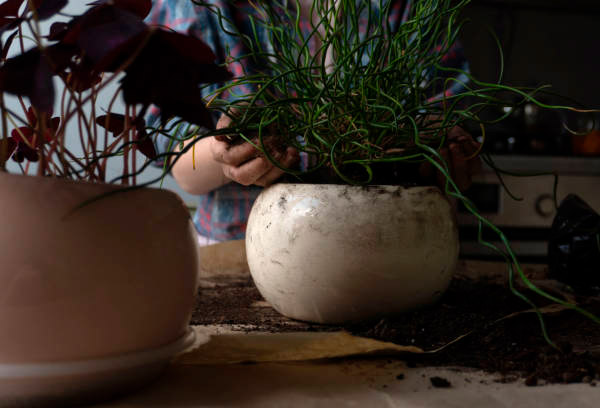
Chemical composition
The chemical composition of juncus is not as extensively studied as that of many other cultivated plants. However, it is known that the stems may contain various organic compounds, including lignin, cellulose, and other components that contribute to stiffness and flexibility. These are used in weaving and the manufacture of decorative items.
In small amounts, juncus tissues may contain flavonoids and other secondary metabolites typical of wetland and coastal plants. Research in this area is ongoing, and it is possible that additional biologically active substances with new properties will be discovered in the future.
Origin
Most species of juncus come from regions with a temperate climate in the Northern Hemisphere. They are most widely distributed in Europe, Asia, and North America, where they grow near bodies of water, in marshy meadows, and on wet slopes. Due to their ability to withstand periodic flooding and lack of oxygen in the soil, juncus easily colonizes coastal areas, forming dense thickets.
In addition to their natural habitats, some species of juncus have been cultivated by humans for centuries, particularly in areas traditionally involved in weaving with natural materials. As a result of cultural spread, juncus has been introduced to other parts of the world, where it has adapted to conditions close to its natural environment—with sufficient soil moisture.
Ease of cultivation
Juncus is considered relatively easy to grow, provided that a few key requirements for growing conditions are met. Thanks to its natural origin from wetland ecosystems, these plants are well adapted to high humidity and can withstand brief flooding. To successfully grow juncus, it is sufficient to provide them with a constantly moist but not waterlogged substrate and adequate lighting.
In indoor horticulture, juncus is often grown as a decorative plant for moist corners or mini-wetlands. They are well suited for terrariums, florariums, and aquatic compositions. With proper care and feeding, juncus can maintain its decorative appearance and greenery throughout the year, becoming an interesting interior element.
Species and varieties
The genus Juncus includes several hundred species, differing in size, stem shape, color, and growth conditions. Some of the most well-known representatives are:
- Juncus effusus (Common Rush): One of the most widespread species, forming large clumps with erect green stems.
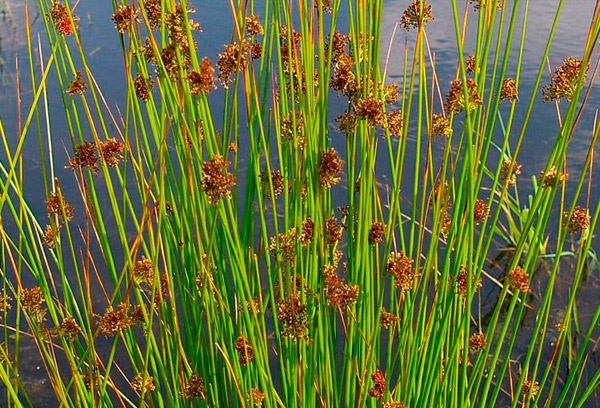
- Juncus inflexus (Hard Rush): Features curved stems with a bluish or silvery hue.
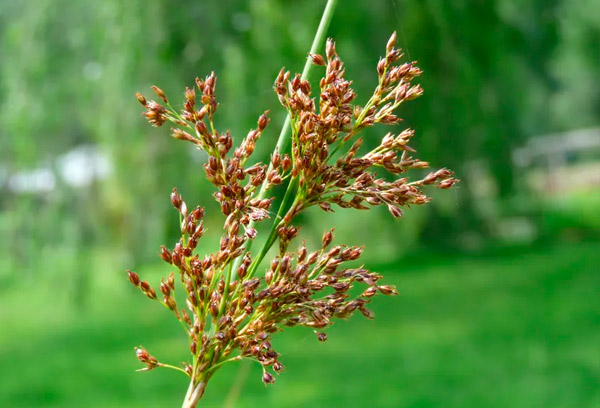
- Juncus spiralis (Spiral Rush): Characterized by spirally twisted shoots, which are very decorative.
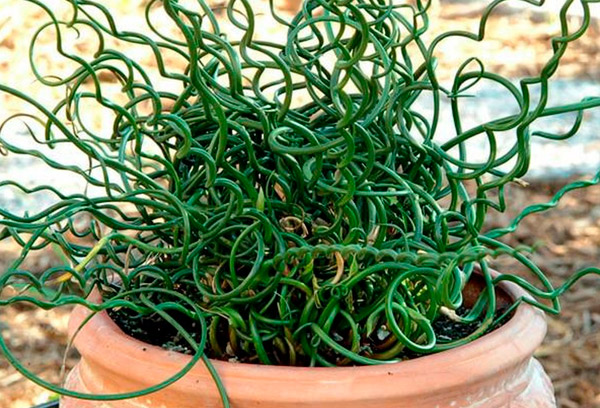
- Juncus tenuis (Path Rush): A miniature species with thin green stems, prefers wet soils.
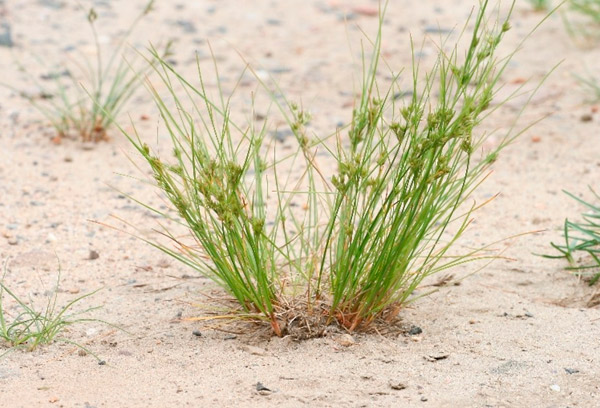
- Hybrids: Some hybrid forms, created by breeders, offer improved decorativeness, stem shapes, and resistance to various conditions.
Size
The size of juncus can vary significantly depending on the species and growing conditions. Some compact species reach only 10–20 cm in height and are ideal for small wet areas or containers. Other, larger species, such as Common Rush, can grow up to 70–100 cm, forming dense thickets.
The height and density of the clump also depend on the level of lighting, soil moisture, and nutrient availability. Under favorable conditions, the juncus rhizomes spread, producing new shoots, allowing the plant to cover large areas.
Growth rate
The growth rate of juncus is determined by its origin from moisture-rich biotopes where nutrients and water are abundant. During the active growth period, which typically occurs in spring and summer, the plant can quickly produce new shoots. However, excessive thickening can lead to competition for resources and a reduction in decorative value.
As autumn approaches and the daylight hours shorten, the growth of juncus may slow down. However, when provided with a stable microclimate—regular watering and adequate lighting—some species can maintain moderate growth even in cooler periods, especially when grown indoors.
Lifespan
Being perennial plants, juncus can live for many years with proper care. In natural conditions, they continuously grow new shoots, while older ones die off, maintaining a stable population. When grown in artificial conditions (in gardens, containers, or indoors), it is important to periodically perform rejuvenation procedures, such as dividing rhizomes and thinning shoots, which helps maintain the plant in good condition.
By avoiding excessive thickening and deterioration of conditions (such as soil acidification or inadequate lighting), juncus can maintain stable growth and greenery for a long time. Regularly renewing some of the shoots ensures that the plant "rejuvenates," and the owner maintains the decorative qualities of the planting.
Temperature
Juncus species can tolerate a wide range of temperatures due to their natural adaptation to humid habitats. The optimal temperature range for most juncus species is 15–25 °C. Under these conditions, the plants grow actively and form dense thickets.
Some species (such as those from mountainous regions) can withstand temporary drops in temperature to 5–10 °C and occasionally even brief frosts. However, sharp temperature fluctuations can negatively affect the plant's appearance: the stems may yellow or dry out. In indoor cultivation, it is recommended to maintain a stable temperature range of 18–22 °C.
Humidity
As moisture-loving plants, juncus prefers high humidity and a constantly moist substrate. In natural conditions, they typically grow near water where the soil does not dry out, and the humidity level often exceeds 70–80%. In indoor conditions, water trays, air humidifiers, or regular misting, especially during the heating season, can be used.
It is important to maintain a balance: excessive waterlogging or lack of substrate aeration can lead to root rot. The optimal humidity level for juncus indoors ranges from 50 to 70%, provided the substrate remains moist but not soggy.
Lighting and placement in the room
Juncus plants prefer bright, diffused light. However, they can also tolerate partial shade, especially for more resilient species. Under insufficient light, the stems may stretch, and the plant's overall appearance loses its decorative quality. The optimal placement would be on a bright windowsill, protected from direct sunlight during midday hours.
If natural light is insufficient, phytolamps or fluorescent lights can be used to provide juncus with the necessary light levels. Placement near a window on the western or eastern side of the room helps maintain a balance between light and moderate sunlight intensity.
Soil and substrate
Soil mix composition: When growing juncus indoors or in containers, it is recommended to use a substrate with a high organic content and moisture retention. The approximate composition is:
- Garden soil – about 40%
- Peat – about 30%
- Sand – about 20% (preferably coarse-grained)
- Perlite – about 10%
Acidity: The optimal pH for juncus soil ranges from 5.5 to 6.5. Slightly acidic or near-neutral pH ensures good nutrient uptake.
Drainage: Although juncus enjoys moisture, a drainage layer made of gravel or expanded clay should still be present at the bottom of the pot to prevent waterlogging, which can cause root rot. It is important to choose a pot with drainage holes to allow excess moisture to escape.
Watering
Summer: During warm weather, juncus requires frequent and abundant watering as it naturally grows in high humidity. The soil should remain constantly moist but not waterlogged. When the top layer of the substrate dries by 1–2 cm, it's time for another watering.
Winter: As temperatures drop, juncus's growth usually slows down, so watering can be reduced, but the substrate should not dry out completely. In winter, it is enough to keep the soil moderately moist. Excess watering during this period increases the risk of rot and fungal infections.
Fertilization and feeding
Fertilizer types: For juncus, use balanced mineral fertilizers with equal amounts of nitrogen, phosphorus, and potassium (NPK). Organic fertilizers (based on humus or compost) can also be used, but in small quantities to avoid excessive foliage growth.
Methods of application: Fertil
Izers are most conveniently applied in liquid form, dissolved in water for irrigation. During active growth, it is recommended to feed juncus every 2–3 weeks to maintain growth. In winter, when growth slows down, reduce the feeding frequency to once a month or stop completely during dormancy.
Flowering
Most species of juncus have inconspicuous flowers, which are gathered in terminal inflorescences or clusters, with a greenish-brown or yellowish hue. Flowering in juncus is short-lived, and many species do not produce attractive blooms in a decorative sense.
When grown indoors, flowering may occur irregularly due to the mismatch of climate conditions typical of the plant's natural habitat. However, even without prominent flowering, juncus is valued for its attractive appearance of stems, which add greenery to the interior.
Propagation
Propagation timing: The best time to propagate juncus is during the spring-summer period when the plant is in the active growth phase. During this time, rhizomes and shoots root well and quickly form new plants.
Rooting methods:
- Cuttings: Separate the rhizome or lateral shoots, which will form new rosettes. After separation, plant the cuttings in a substrate with a high organic content.
- Seed propagation: Seeds are sown on the surface of moist substrate, lightly covered with sand, and kept in a humid environment until germination. This method takes more time and patience, as seedlings may take several weeks or even months to appear.
Seasonal features
In spring and summer, juncus shows the most intense growth activity, forming new stems and leaves. During this time, it is important to ensure the plant has sufficient moisture and nutrients. In autumn, growth slows down, and the plant may enter dormancy or undergo slow development.
In winter, some species of juncus maintain partial activity, especially if kept in a room with moderate temperatures and stable watering. However, with temperature drops and shorter daylight, growth weakens, and the plant may require less frequent watering and feeding.
Care features
Caring for juncus involves maintaining optimal soil moisture, sufficient light levels, and regular fertilization. It is also important to periodically thin the plant, removing old and damaged stems to ensure good air circulation and prevent overcrowding. When growing indoors, it is advisable to monitor air humidity levels, using a humidifier or a tray of water.
It is also crucial to ensure that the substrate is not oversaturated with moisture, as stagnant water can lead to root rot. Regularly inspecting the plant allows you to identify issues (diseases, pests) early and take corrective actions.
Indoor care
Indoor juncus is typically grown in pots or containers that allow for control over soil moisture levels and easy movement if needed. The optimal place for placement is a bright windowsill where the plant receives sufficient diffused light but is not exposed to direct sunlight for long periods.
Watering should be done regularly, keeping the substrate constantly moist but not soggy. During the summer, water 2–3 times a week, and reduce watering frequency in winter to avoid over-watering. You can use filtered or distilled water at room temperature.
To maintain high humidity, you can mist the stems and surrounding area with soft water or place the pot on a tray with moist gravel or sphagnum moss. However, it's important to provide adequate ventilation to prevent excessive moisture buildup, which can lead to fungal diseases.
Repotting
Pot Selection: When repotting juncus, it's important to select a container that is slightly larger than the previous one to allow the root system to grow. The pot should have adequate drainage holes to prevent water stagnation around the roots. Plastic or ceramic pots are preferable, as plastic makes the plant easier to move, while ceramic pots provide more stable conditions for the roots.
When to Repot: Repotting should be done every 1–2 years or when necessary, such as when the roots no longer fit in the old pot or when the substrate starts to decompose and lose aeration. The best time to repot is in spring or early summer when the plant is actively growing. In case of significant rhizome growth, the clump can be divided, separating healthy parts of the root system and repotting them into separate containers.
Pruning and shaping
Juncus typically does not require special shaping pruning, as its stems grow vertically and form a characteristic dense clump. However, it is recommended to periodically remove dried or damaged stems to maintain an attractive appearance and stimulate the formation of new shoots. Such sanitary pruning also reduces the risk of fungal infections.
If the plant has favorable lighting and space conditions, some stems can be trimmed to give the composition a neater appearance. It’s important to use sharp and sterile tools when cutting the stems, cutting them at the substrate or rhizome level to avoid leaving "stumps" that could lead to rotting.
Potential problems and their solutions
Diseases: Juncus can suffer from fungal and bacterial infections, most commonly related to excessive moisture and insufficient air circulation. To combat diseases, fungicides are used, and watering practices are adjusted to reduce overwatering. It is important to remove affected stems and rhizomes promptly.
Nutrient Deficiency: Yellowing of leaves, slow growth, and lack of flowering may indicate a deficiency of nitrogen or other nutrients. Regular feeding and substrate renewal help to avoid these issues. Care mistakes such as infrequent watering or insufficient light can also negatively affect the overall health of the juncus.
Pests
Main Pests: Juncus is susceptible to pests such as aphids, spider mites, mealybugs, and thrips. These insects feed on the plant’s juices, weakening it and causing deformations of the stems. When pests reproduce in large numbers, they can cause significant damage to the clump.
Prevention: Regularly inspect the plant, maintain cleanliness, and ensure optimal humidity to reduce the likelihood of pest infestations. If pests are found, insecticides can be used according to the recommended doses and application periods. For a more environmentally friendly approach, biological methods (predatory insects, bioinsecticides) or home remedies (soap solution) can be used.
Chemical Protection: In case of severe infestations, chemical insecticides may be used, but it’s essential to consider the safety of the surrounding environment and people by following the manufacturer’s instructions and precautions.
Air purification
Like many other houseplants, juncus can help purify the air by removing harmful impurities and dust. Through the process of photosynthesis, the plant releases oxygen and absorbs carbon dioxide, improving the indoor microclimate. The stiff stems of juncus trap dust, which is then washed away during misting or watering.
The "green filter" effect is especially valuable in urban apartments, where air pollution levels may be high. Although juncus's ability to purify the air may not be as strong as some other plants, its role in creating a healthier and more pleasant atmosphere indoors should not be underestimated.
Safety
Toxicity: Most species of juncus do not contain toxic substances that are dangerous to humans or pets. However, consuming the plant's stems or roots in large quantities may lead to indigestion or stomach irritation, as it is intended for decorative purposes.
Allergic Reactions: Some people may experience mild allergic reactions to pollen particles or sap from plants in the Juncaceae family. If itching or redness of the skin occurs upon contact with the plant, it is recommended to limit direct contact and consult a doctor if necessary.
Wintering
Wintering Conditions: In natural conditions, juncus can endure periods of cold, especially in regions with a temperate climate. In indoor horticulture, the plant typically continues to grow during the winter if it receives adequate lighting and maintains a stable temperature around 18–20 °C. However, growth may slow down, and watering requirements will decrease.
Preparation for Spring: By the start of spring, juncus resumes active development, forming new shoots. Watering and fertilization can be gradually increased during this time. If grown outdoors, it is advisable to wait for stable warm temperatures and avoid the return of frost, especially if the root system has already started active growth.
Beneficial properties
Water Regulation Role: In its natural environment, juncus helps stabilize the shorelines of bodies of water by preventing soil erosion and providing additional water filtration. This contributes to ecosystem preservation and water quality improvement.
Cultural and Economic Value: Due to its stiff and elastic stems, juncus has been historically used for weaving baskets, ropes, and mats. While these traditional methods have been replaced by modern materials, interest in traditional weaving techniques remains, and juncus continues to be used as raw material for crafts.
Use in traditional medicine or folk recipes
In some cultures, especially in Asia, juncus species have been used in traditional medicine. Infusions and decoctions made from juncus stems were used to alleviate cold symptoms, inflammation, and to improve digestion. However, scientific studies supporting the effectiveness of these methods are limited.
In modern phytotherapy, juncus is rarely used, and its application is mainly associated with folk recipes. Before using any plants for medicinal purposes, it is recommended to consult with a specialist, as the safe dosage and potential side effects may not be well studied.
Use in landscape design
Decorative Compositions: Juncus is ideal for creating aquatic and wetland compositions in gardens. Its straight or curved stems add verticality and texture diversity, harmonizing with other moisture-loving plants. Along the shore of a pond or in special bog beds, juncus helps form a natural appearance of the water body.
Vertical Gardens and Hanging Compositions: Thanks to its ability to tolerate high humidity and adequate lighting, juncus can be placed in hanging baskets or containers arranged vertically. This spatial organization gives the garden or terrace a unique look, and the contrasting shapes and shades of juncus make an expressive accent.
Compatibility with other plants
Growing Together: Juncus thrives alongside plants that share a love for moisture and prefer slightly acidic soil. These might include sedges, bulrushes, marsh irises, and other species found in the coastal zone. In high humidity conditions, such plants form dense green masses that are ecologically stable.
Combining with Different Species: In garden planning or indoor compositions, juncus can serve as a background for brighter flowering plants, highlighting their decorativeness. In water gardens and paludariums, the combination of different moisture-loving plants creates a multi-layered planting, with juncus occupying the lower or middle layers.
Conclusion
Juncus (juncus) is an interesting representative of the Juncaceae family, possessing valuable properties both in natural ecosystems and in cultivated settings. Its ability to stabilize wet soils, its adaptability to various conditions, and its unique appearance make juncus plants useful and attractive for landscape design and indoor gardening.
With proper care, juncus can retain its decorative quality for many years, delighting with its stiff stems and creating a special atmosphere around water bodies or in areas with high humidity. Their hardiness and ecological role highlight the uniqueness of these plants and their importance for preserving biodiversity.
